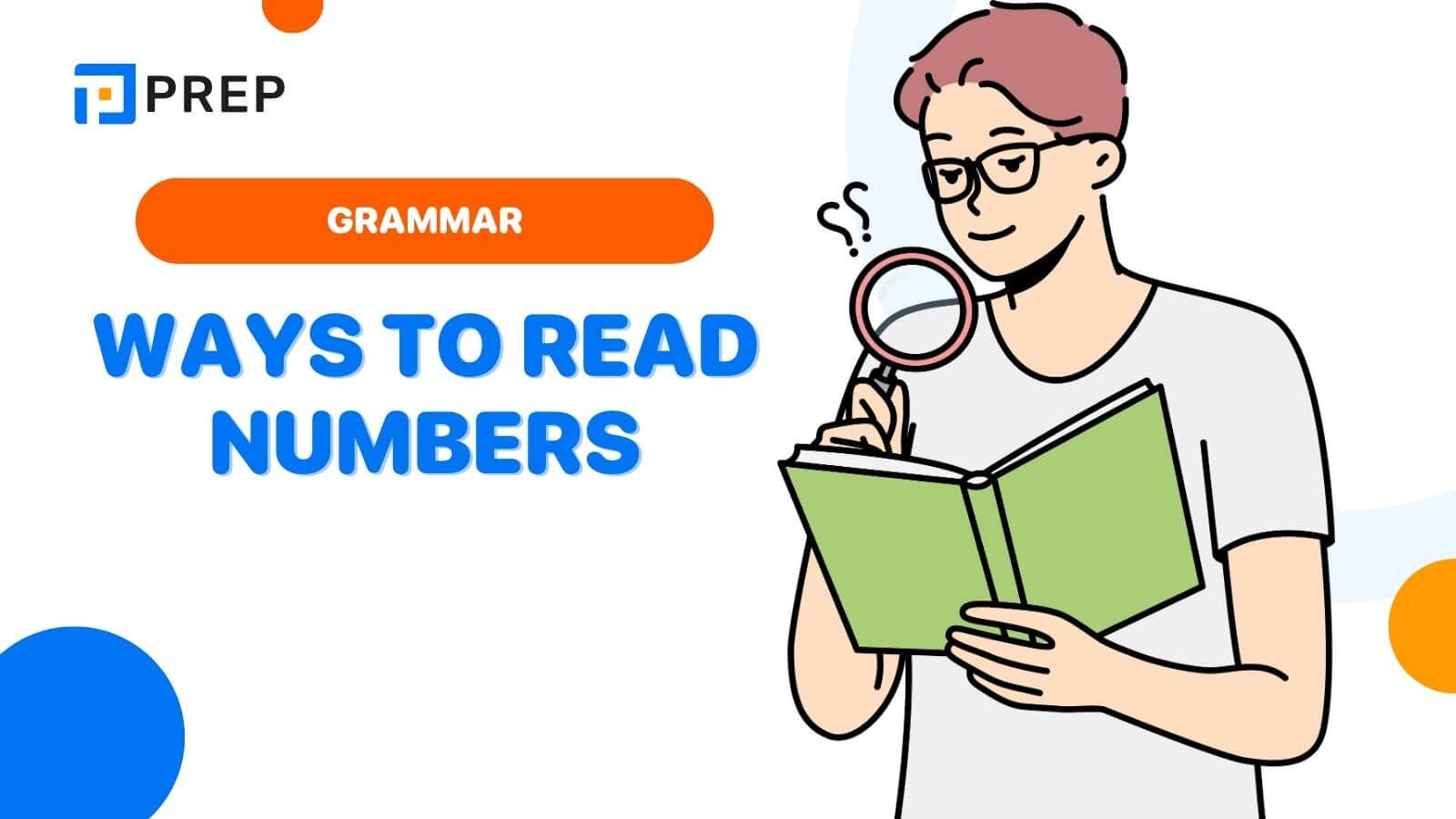16 Ways to Read Numbers in English - Rules to Conquer 9.0 Listening
Certainly, if you want to achieve a high score in the Listening section of the IELTS and TOEIC exams, you must master the correct way to read numbers in English. However, for some, reading numbers in English can be quite a "nightmare." With the aim of helping you excel in your Listening tests, here are some fundamental rules for reading numbers in English. Let's look at these "must-know" rules with PREP!
- I. How to Read Cardinal Numbers in English
- II. How to Read Ordinal Numbers in English
- III. How to Read Dates in English
- IV. How to Read a Sequence of Numbers in English
- V. How to Read Decimals in English
- VI. How to Read Exponents in English
- VII. How to Read Fractions in English
- VIII. How to Read Mixed Numbers in English
- IX. How to Read Negative Numbers in English
- X. How to Read Measurements in English
- XI. How to Read Money in English
- XII. How to Read Percentages in English
- XIII. Exercises on How to Read Numbers in English

I. How to Read Cardinal Numbers in English
Mastering how to read different types of numbers in English will help you conquer the IELTS and TOEIC Listening tests with high band scores. Let’s remember the following key concepts!
1. How to Read Numbers from 1 to 100
For cardinal numbers, you need to memorize and keep in mind the following rules:
|
Type of number |
Reading Rules |
Example |
|
Numbers from 1 to 12 |
You need to memorize the numbers from 1 to 12. This is the foundation for learning larger numbers. |
|
|
Tens |
The suffix -teen: used for numbers from 13 to 19. |
|
|
The suffix -ty: used for round tens starting from 20 and above. |
|
|
|
From 20 and up: Round tens + single units. |
|
Some Notes When Reading Numbers from 1 to 100:
-
The numbers 11 (eleven /əˈlev.ən/) and 12 (twelve /twelv/) have special pronunciations.
-
Numbers consisting of tens with single units require a hyphen (“-”). For example, 45 is read as "forty-five" and not "forty five."
-
The number 0 is read as zero /ˈzɪr.oʊ/.
2. How to Read Hundreds
"Hundred," pronounced /ˈhʌn.drəd/. The general principles for reading hundreds are as follows:
-
Reading Hundreds: Read the hundreds as usual (one hundred, two hundred, three hundred...), then continue with the rest of the number. For example:
-
125: one hundred twenty-five
-
342: three hundred forty-two
-
508: five hundred eight
-
-
The word "and": It is commonly used to connect the hundreds to the tens and units. However, in American English, the word "and" is often omitted in some cases. For example:
-
256: two hundred fifty-six (or two hundred and fifty-six)
-
304: three hundred four (or three hundred and four)
-
891: eight hundred ninety-one (or eight hundred and ninety-one)
-
Notes:
-
If the tens or units part is 0, you can skip reading it. For example, 400 is read as "four hundred."
-
Examples of Reading Hundreds in Different Situations:
-
Phone number “555-1234”: five five five one two three four
-
Price “$345”: three hundred forty-five dollars
-
House number “123 Main Street”: one hundred twenty-three Main Street
3. How to Read Thousands
Principles:
-
Read the thousands first: Read the thousands as you would read cardinal numbers, then add the word "thousand" /ˈθaʊ.zənd/. For example:
-
10,000: ten thousand
-
20,000: twenty thousand
-
-
Continue with the rest: After reading the thousands, continue to read the hundreds, tens, and units. For example:
-
1,234: one thousand two hundred thirty-four
-
5,678: five thousand six hundred seventy-eight
-
Note: The word "and" is often used to connect the parts, but it is not mandatory. For example:
-
1,234 can be read as "one thousand two hundred and thirty-four."
-
5,713 can be read as "five thousand seven hundred and thirteen."
4. How to Read Millions
Principles
-
Read the millions first: Read the millions as you would read cardinal numbers, then add the word "million" /ˈmɪl.jən/. For example:
-
1,000,000: one million
-
3,000,000: three million
-
-
Continue with the rest: After reading the millions, you continue to read the thousands, hundreds, tens, and units. For example:
-
2,345,678: two million three hundred forty-five thousand six hundred seventy-eight.
-
7,903,713: seven million nine hundred three thousand seven hundred thirteen.
-
Note: The word "and" is often used to connect the parts, but it is not mandatory. For example:
-
5,679,245: five million six hundred and seventy-nine thousand two hundred and forty-five.
-
6,481,332: six million four hundred and eighty-one thousand three hundred and thirty-two.
II. How to Read Ordinal Numbers in English
Typically, to read ordinal numbers in English, you simply add the suffix -th to the end of the cardinal number. Note that you must pronounce the final sound th /θ/. For example: seventh, eleventh, twelfth, seventeenth, twentieth, one hundredth, one thousandth, one millionth.
Special Cases:
-
Number 1: first
-
Number 2: second
-
Number 3: third
-
Number 5: fifth
-
Number 8: eighth
-
Number 12: twelfth
-
Cardinal numbers ending with the suffix “-ty” change to “-tieth” when in ordinal form: twenty → twentieth.
-
Numbers ending in 1 (except 11): add "-st"
-
Numbers ending in 2 (except 12): add "-nd"
-
Numbers ending in 3 (except 13): add "-rd"
-
All other numbers: add "-th"
For example:
-
32nd: thirty-second
-
43rd: forty-third
-
100th: one hundredth
III. How to Read Dates in English
Typically, when writing dates, the British and Americans have different formats. However, when reading them, the pronunciations are quite similar. Pay attention to the order for reading and writing dates in British and American English:
|
|
Formula |
Reading format |
Written format |
|
British English |
Day - date - month - year |
Monday, the sixth of November, twenty-twenty |
Monday, 6th November 2020 |
|
American English |
Day - month - date - year |
Monday, November sixth, twenty twenty |
Monday, November 6th, 2020 |
To be specific:
|
Reading format |
Example |
|
Dates: According to the rules in section II.
|
23rd: twenty-third |
|
Months: Read the names of the months of the year: |
|
|
Years: You can read years in either sequence or by their units. |
|
IV. How to Read a Sequence of Numbers in English
When taking the IELTS Listening test, especially in Listening Part 1, you will frequently encounter conversations containing sequences of numbers such as phone numbers, bank card numbers, account numbers, etc. To listen and record the correct answers, be sure to master the following ways to read sequences of numbers:
How to Read a Sequence of Numbers in English:
-
Read each number separately: Each digit in the sequence is read individually, as you would read cardinal numbers. For example: 987654: Nine, eight, seven, six, five, four.
-
Use appropriate pauses: Between groups of numbers, you can take short pauses to make it easier to hear and write down. For example: 1234567890: One two three, four five six, seven eight nine zero (pause after each group of three numbers).
-
Emphasize important numbers: Depending on the context, you can emphasize important numbers such as the first number, the last number, or special numbers (e.g., the number 0). For example: 0987 654 321: Zero nine eight seven, six five four, three two one. (Emphasize the first four numbers to distinguish the area code).
-
Read adjacent numbers:
-
Two adjacent numbers are read as "double + the number." For example: 0988 654 321: Zero nine double eight, six five four, three two one.
-
Three adjacent numbers are read as "triple + the number." For example: 07888 654 321: Zero nine triple eight, six five four, three two one.
-
Notes on reading the number 0 in a sequence:
-
Zero: This is the standard reading and is often used in formal situations or when emphasizing the number 0.
-
Oh: This reading is commonly used in everyday conversations, phone numbers, or when reading consecutive numbers with many zeros. In the IELTS Listening test, when 0 appears at the beginning of a number sequence, it is often read as "oh."
V. How to Read Decimals in English
When reading decimal numbers in English, we commonly use the word "point" to separate the whole part from the decimal part.
General Reading Rules:
-
Read the whole part: Read the whole number as you normally would.
-
Read "point": Use the word "point" to indicate the decimal point.
-
Read the decimal part: Read each digit after the decimal point individually.
For example:
-
3.14: Three point one four.
-
2.75: two point seven five
-
4.6: four point six
Note: For currency, you need to clearly state the currency unit and separate the whole number part from the decimal part:
-
$15.82: Fifteen dollars and eight-two (cents).
-
€180.05: One hundred and Eighty euros and five (cents).
VI. How to Read Exponents in English
The rules for reading exponents are an important aspect of reading numbers in English that you should pay attention to. For exponents of 4 and higher, we read them using the structure:
Base number + to the power of + exponent
For example:
-
2^4: two to the power of four
-
5^8: five to the power of eight
For exponents of 2 and 3, we can use the shorthand terms "squared" (for exponent 2) and "cubed" (for exponent 3). Examples:
-
3^2: three squared
-
7^3: seven cubed
-
10^2: ten squared
VII. How to Read Fractions in English
For fractions where the numerator is less than 10 and the denominator is less than 100, we use cardinal numbers to read the numerator and ordinal numbers to read the denominator. If the numerator is greater than 1, we add "s" to the denominator.
-
1/3: one-third
-
1/2: one half
-
9/15: nine-fifteenths
-
2/5: two-fifths
-
2/9: five-ninths
For fractions where the numerator is greater than 10 or the denominator is greater than 100, we use cardinal numbers for both the numerator and the denominator, connecting the two with "over."
-
20/9: twenty over nine
-
21/135: twenty-one over thirty-five
-
2/134: two over one three four
Additionally, there are some special cases where a fraction has different ways of reading:
-
1/2: one half
-
1/4: one fourth = one quarter = a quarter
-
3/4: three fourths = three quarters
VIII. How to Read Mixed Numbers in English
Mixed numbers may not be commonly encountered in tests or everyday communication, but it is important to know how to read them in English. For mixed numbers, the whole number part is read as a cardinal number, followed by the fraction part using "and."
|
Mixed Number |
How to Read |
|
|
Five and three quarters |
|
|
Three and one fifth
|
Notes on Special Cases:
|
Case |
Example |
How to read |
|
Denominator is 2: Read as "half" |
|
One and a half |
|
Denominator is 4: Read as "quarter"
|
|
Two and a quarter |
|
Other Denominators: Read the numerator followed by the denominator. Add "s" to the denominator if it is greater than 1. |
|
Three and one fifth |
IX. How to Read Negative Numbers in English
To read a negative number in English, we simply add the word "negative" /ˈneɡ.ə.t̬ɪv/ or "minus" /ˈmaɪ.nəs/ before the number. The rest of the number is read just like a cardinal number. For example
-
-5: Negative five or Minus five
-
-12: Negative twelve or Minus twelve
-
-20.5: Negative twenty point five or Minus twenty point five
For example:
-
The word "minus" can also be used to indicate a negative number, but "negative" is more commonly used in English.
-
When reading large negative numbers, we typically read them in groups of three digits, just like we do with positive numbers.
-
-123,456 will be read as "negative one hundred twenty-three thousand, four hundred fifty-six."
-
-438,731 will be read as "negative four hundred thirty-eight thousand seven hundred thirty-one."
-
X. How to Read Measurements in English
|
Measurement Reading |
Example |
|
Length: Read the cardinal number normally and add the unit of measurement for length after the number.
|
|
|
Weight: Read the cardinal number normally and add the unit of measurement for weight after the number.
|
|
|
Volume: Read the cardinal number normally and add the unit of measurement for volume after the number.
|
|
XI. How to Read Money in English
To read an amount of money, for whole amounts, read it as you would a cardinal number, then add the name of the currency unit.
For example:
-
$100: one hundred dollars
-
$250: two hundred and fifty dollars
If the amount of money is in decimal form, read it similarly to how you would read decimal numbers, then add the currency unit at the end.
For example:
-
$3.50: three dollars and fifty cents hoặc three dollars fifty
-
€12.66: twelve euros and sixty-six cents hoặc twelve euros sixty-six
Note: Ordinary decimal numbers are not read in this way. These rules only apply to currency.
XII. How to Read Percentages in English
Reading percentages in English is quite simple; you just read the number as you normally would and then add the word "percent" /pɚˈsent/ at the end.
-
25%: twenty-five percent
-
50%: fifty percent
-
75%: seventy-five percent
XIII. Exercises on How to Read Numbers in English
Let’s practice with some exercises below to solidify your understanding of how to read numbers in English!
|
Exercise 1: Write how to read the following numbers.
|
Exercise 2: Match the options 1 - 10 with the numbers from A - J. |
|
|
1. One thousand two hundred thirty-four 2. Twenty-three thousand four hundred fifty-six 3. Nine hundred eighty-seven thousand six hundred fifty-four 4. Twelve million three hundred forty-five thousand six hundred seventy-eight 5. One hundred twenty-three million four hundred fifty-six thousand seven hundred eighty-nine 6. Nine billion eight hundred seventy-six million five hundred forty-three thousand two hundred ten 7. Four hundred thirty-two thousand one hundred 8. Fifty-six thousand seven hundred eighty-nine 9. One million 10. Three billion four hundred fifty-six million seven hundred eighty-nine thousand twelve |
A. 9,876,543,210 B. 1,234 C. 23,456 D. 56,789 E. 987,654 F. 123,456,789 G. 3,456,789,012 H. 432,100 I. 12,345,678 J. 1,000,000 |
Answer key:
|
Exercise 1 |
Exercise 2 |
|
1 - B 2 - C 3 - E 4 - I 5 - F 6 - A 7 - H 8 - D 9 - J 10 - G |
This article provides a complete guide on how to read numbers in English that you need to master. Practice with various listening exercises to remember the reading more effectively! Wishing you success in your self-study and achieving a high band score in the IELTS or TOEIC Listening tests.

Hi I'm Chloe, and I am currently serving as an Product Content Administrator at Prep Education. With over five years of experience in independent online IELTS study and exam preparation, I am confident in my ability to support learners in achieving their highest possible scores.
Comment
Premium content
View allPersonalized roadmap
Most read












